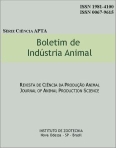Nutritional limitations to the development of perennial soybean grown in a mixed jaraguá grass pasture
Abstract
Two experiments were carried out in a greenhouse in the Instituto de Zootecnia at Nova Odessa, State of São Paulo, where perennial soybean was grown in a Ortho Dark-Red Latosol withdrew from a mixed pasture (jaraguá grass plus perennial soybean, siratro, centro and stylo) fertilized three years before with levels of single superphosphate (0 and 150 quilograms of P2O5 per hectare, named PO and P2). The results showed that phosphorus was the most limiting factor to the dry matter production, nodulation and total amount of nitrogen of perennial soybean. The €œminus lime€ treatment depressed the dry matter production of the plat tops, of the hole plants and the number of nodules of the legume. It was observed a residual effect of the fertilization with single superphosphate in the development of the legume. The €œminus potassium€, €œminus borum€ and €œminus molibdenum€ treatments were restrictive to the growth of perennial soybean in the soil from P2 Sulphur applied at 90kg/ha caused significant increases in the total amounth of nitrogen in the plant tops and hole plants. These effects were not observed when 30kg S/ha was applied.Downloads
Downloads
Published
Issue
Section
License
Os autores não serão remunerados pela publicação de trabalhos, pois devem abrir mão de seus direitos autorais em favor deste periódico. Por outro lado, os autores ficam autorizados a publicar seus artigos, simultaneamente, em repositórios da instituição de sua origem, desde que citada a fonte da publicação original seja Boletim de Indústria Animal. A revista se reserva o direito de efetuar, nos originais, alterações de ordem normativa, ortográfica e gramatical, com vistas a manter o padrão culto da língua e a credibilidade do veículo. Respeitará, no entanto, o estilo de escrever dos autores. Alterações, correções ou sugestões de ordem conceitual serão encaminhadas aos autores, quando necessário. Nesses casos, os artigos, depois de adequados, deverão ser submetidos a nova apreciação. As opiniões emitidas pelos autores dos artigos são de sua exclusiva responsabilidade. Todo o conteúdo deste periódico, exceto onde está identificado, está licenciado sob a Licença Creative Commons Attribution (CC-BY-NC). A condição BY implica que os licenciados podem copiar, distribuir, exibir e executar a obra e fazer trabalhos derivados com base em que só se dão o autor ou licenciante os créditos na forma especificada por estes. A cláusula NC significa que os licenciados podem copiar, distribuir, exibir e executar a obra e fazer trabalhos derivados com base apenas para fins não comerciais.













